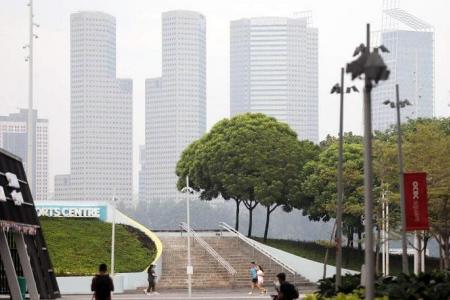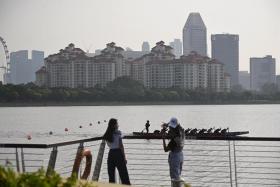Can I use a surgical mask instead of an N95 when there is haze?
This year’s hot and dry season, expected to be prolonged and more intense, has arrived, bringing with it a higher risk of transboundary haze in Singapore.
Two climate phenomena – the warming El Nino and the positive Indian Ocean Dipole – are predicted to occur in the second half of 2023, extending the dry period to October.
Here are some ways to prepare for possible haze, where higher concentrations of particles and pollutants are suspended in the air.
What precautions do I take when there is haze?
Refer to the 24-hour PSI (Pollutant Standards Index) forecast to plan activities the next day, and the hourly PM2.5 readings to decide on immediate outdoor activities. PM2.5 – tiny, harmful particles that can penetrate deeply into the lungs – is the dominant pollutant during episodes of transboundary haze.
If the 24-hour PSI reaches unhealthy levels (101 and above), individuals with chronic lung or heart disease, for instance, should avoid prolonged or strenuous exertion outdoors.
Seniors, pregnant women and children should minimise outdoor exertion.
If the one-hour PM2.5 concentration reaches elevated levels, healthy people should reduce strenuous outdoor activities, while vulnerable people should avoid such activities.
Haze particles can cause respiratory symptoms and aggravate existing heart or lung disease. Symptoms may show one to three days after exposure.
In healthy individuals, exposure to high levels of haze particles may cause irritation of the eyes, nose and throat.
Such irritation resolves on its own in most cases.
When do I use an N95 mask?
While N95 masks are not needed indoors or during short exposure such as while commuting, a healthy person who has to be outdoors for several hours when the air quality is in the hazardous range (PSI levels above 300) may protect himself by wearing an N95 mask.
For vulnerable individuals, the best protection is to avoid or minimise outdoor activities when the forecast air quality is very unhealthy (PSI levels above 200). If they have to be outdoors for several hours, they may wear an N95 mask.
Can I use a surgical mask instead of an N95 mask when there is haze?
No. Normal surgical masks are not effective in filtering out fine particles like PM2.5. Surgical masks protect the wearer from infectious droplets and sprays.
N95 masks are about 95 per cent effective in protecting the wearer from airborne particles as tiny as 0.1 to 0.3 microns.
For the best protection, the N95 mask has to be fitted well. For proper fit, ensure that the mask is the right size and covers the nose and mouth comfortably without gaps.
Can N95 masks be reused?
The N95 can be reused up to five times unless it gets soiled or distorted in shape.
There are reusable N95 masks such as the Envo respirator.
Users should ensure that the N95 masks they buy are certified by the United States National Institute for Occupational Safety and Health.
What precautions do I take indoors when there is haze?
* Shut doors and windows when the outdoor air quality appears to be worsening.
* Reduce other sources of indoor air pollution, such as cigarettes and candles.
* Wet-cleaning methods such as mopping or wiping can be used to remove settled dust at home.
* Fans or air-conditioners may be used for air circulation and cooling. If the air-conditioner draws in unfiltered air from outside, close the outdoor air-intake opening.
* Use an air purifier.
* Declutter to reduce the number of areas that will collect dust.
What kind of air purifiers should I choose?
To remove fine particles, highly efficient filters, such as High Efficiency Particulate Air filters, are ideal.
Some air purifiers are labelled with a clean air delivery rate (CADR), which has three CADR numbers – one each for smoke, dust and pollen. The smoke CADR is the most appropriate for haze pollutants.
Appropriate air purifiers should have a smoke CADR number that is at least three times the volume of the room in cubic m. A larger number means faster cleaning in an enclosed room.
As a guide, households may refer to the National Environment Agency’s list of portable air filters here: https://str.sg/i3wD
Get The New Paper on your phone with the free TNP app. Download from the Apple App Store or Google Play Store now


